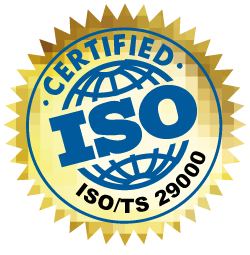
ISO 55001 Certification
ISO 55001 is an international standard that specifies the requirements for an asset management system (AMS). It provides a structured framework for managing physical assets effectively and efficiently throughout their lifecycle. This standard helps organizations realize value from their assets, improve operational performance, and achieve strategic objectives.
ISO 55001 certification demonstrates that an organization has implemented a robust asset management system in line with the best practices outlined in the ISO 55000 series. The certification ensures that the organization has the policies, processes, and procedures in place to manage assets systematically and sustainably.
The standard applies to all types of assets and organizations of all sizes and sectors, from manufacturing and utilities to transportation and healthcare.
- Improved Asset Performance: Helps organizations optimize the performance and reliability of their assets, reducing downtime and operational disruptions.
- Cost Efficiency: Enhances cost management by identifying cost-effective maintenance strategies and reducing unnecessary expenditures.
- Risk Mitigation: Provides a structured approach to identifying, assessing, and managing risks associated with assets, minimizing potential failures and accidents.
- Regulatory Compliance: Assists organizations in meeting legal and regulatory requirements related to asset management.
- Strategic Alignment: Aligns asset management activities with the organization’s strategic goals, ensuring that assets support business objectives.
- Sustainable Practices: Encourages sustainable asset management practices, reducing environmental impact and promoting long-term sustainability.
- Enhanced Decision-Making: Provides reliable data and insights for informed decision-making regarding asset investments and management.
- Stakeholder Confidence: Builds trust and confidence among stakeholders, including customers, investors, and regulators, by demonstrating a commitment to effective asset management.
The certification process for ISO 55001 involves several steps to ensure that the organization’s asset management system meets the standard’s requirements:
Gap Analysis:
- Conduct an initial assessment to identify gaps between the current asset management practices and the ISO 55001 requirements.
Planning and Training:
- Develop a plan to address identified gaps. Train employees on the principles and requirements of ISO 55001 and the asset management system.
Documentation:
- Create or update necessary documentation, including the asset management policy, objectives, and procedures, to comply with ISO 55001.
Implementation:
- Implement the asset management system across the organization, ensuring all processes are followed as documented.
Internal Audit:
- Conduct internal audits to evaluate the effectiveness of the asset management system and ensure compliance with ISO 55001.
Management Review:
- Top management should review the asset management system to ensure its continuing suitability, adequacy, and effectiveness.
Certification Audit:
- An accredited certification body conducts a certification audit, including a thorough review of the asset management system documentation and an on-site assessment of the implementation.
Certification Issuance:
- If the audit is successful, the certification body issues an ISO 55001 certificate, valid for three years, subject to annual surveillance audits.
Continuous Improvement and Surveillance Audits:
- Maintain the asset management system and continually improve processes. Certification bodies conduct annual surveillance audits to ensure ongoing compliance with ISO 55001.
- Optimized Asset Performance:Helps organizations achieve optimal performance and utilization of assets, leading to increased productivity and reduced operational costs.
- Improved Risk Management:Provides a structured approach to identifying and mitigating risks associated with assets, enhancing operational resilience.
- Cost Savings:Reduces maintenance and operational costs through effective asset management strategies and practices.
- Enhanced Strategic Planning:Aligns asset management activities with the organization’s strategic goals, supporting long-term planning and investment decisions.
- Regulatory Compliance:Assists in meeting regulatory and legal requirements related to asset management, reducing the risk of non-compliance and associated penalties.
- Sustainability:Promotes sustainable asset management practices, reducing environmental impact and contributing to long-term sustainability goals.
- Stakeholder Trust:Builds trust and confidence among stakeholders by demonstrating a commitment to effective and responsible asset management.
- Continuous Improvement:Fosters a culture of continuous improvement in asset management practices, driving ongoing enhancements in performance and efficiency.
- Manufacturers: To optimize the performance and reliability of production equipment and facilities.
- Utilities: To ensure the efficient and reliable operation of infrastructure, such as power plants, water treatment facilities, and distribution networks.
- Transportation: To manage the lifecycle of vehicles, infrastructure, and other transportation assets.
- Healthcare: To maintain and optimize medical equipment and facilities, ensuring the highest standards of care.
- Real Estate: To manage property assets effectively, maximizing value and performance.
- Public Sector: To ensure the efficient and sustainable management of public assets and infrastructure.
Our most Honorable Clients
















Join Us
Global Certifications
Have questions about our certification process? Need guidance on which certification suits your needs? We’re here to help every step of the way.
Testimonial





